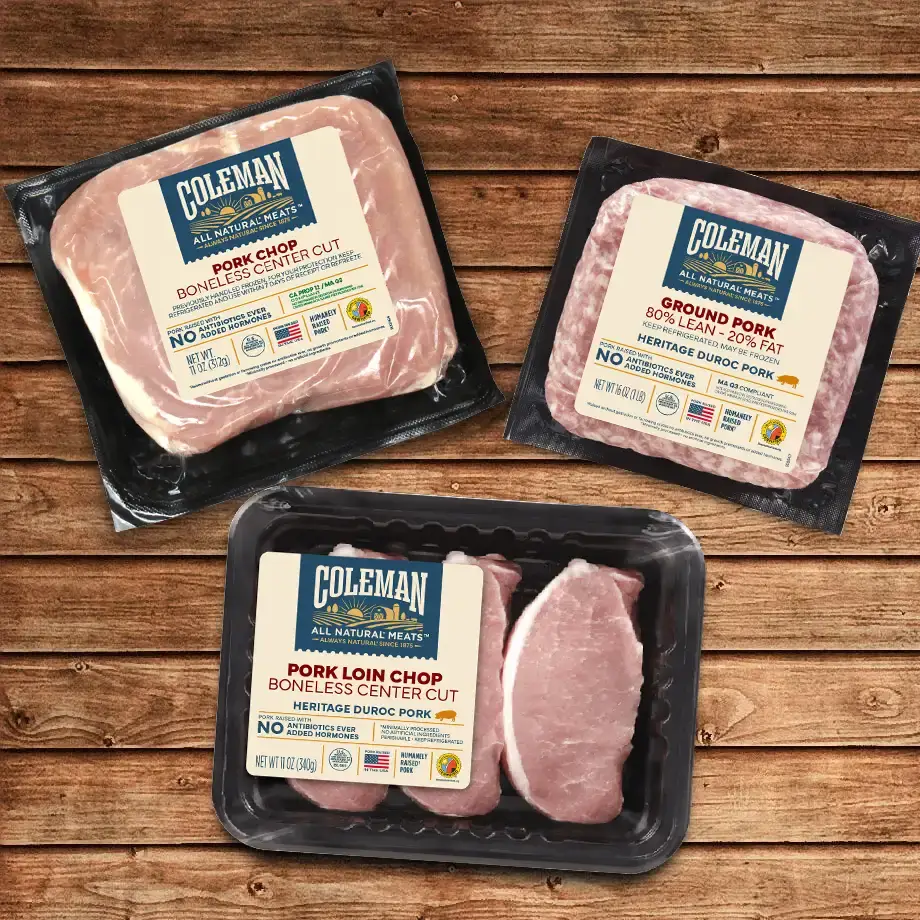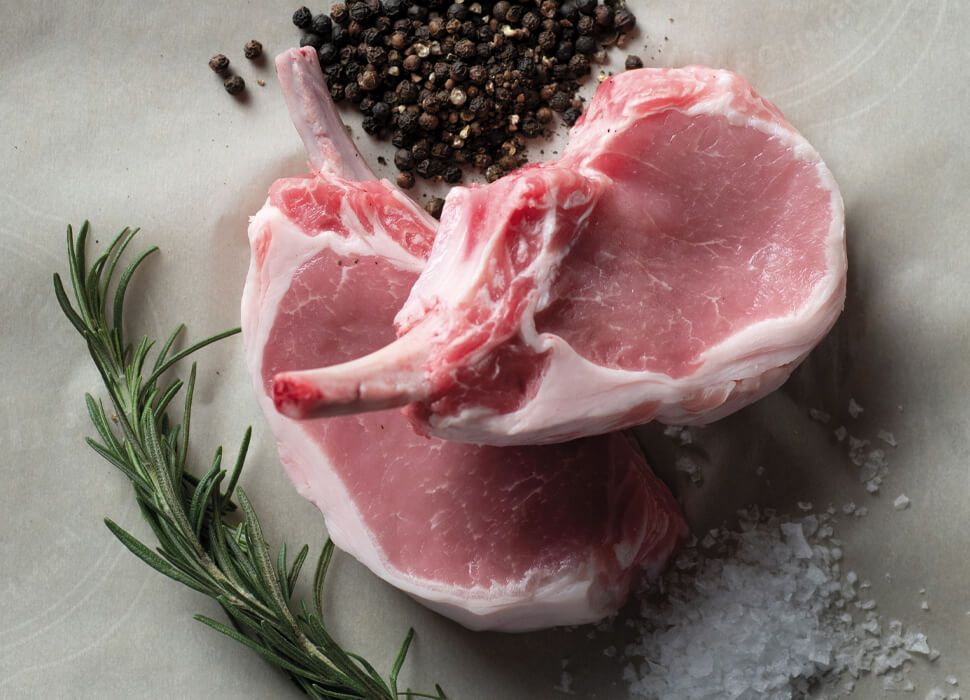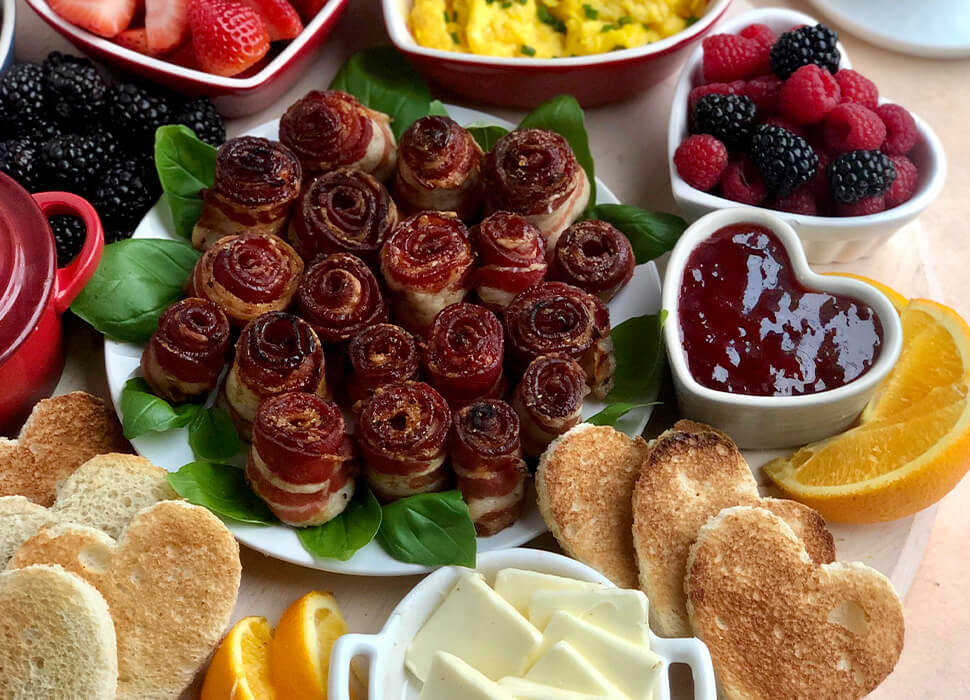Versatile and delicious, pork is appropriate for any occasion. Grill some quick pork chops or a tenderloin for weeknights, slow-roast a pork butt for weekends, or enjoy a celebratory ham for a holiday!
But with so many cuts and cooking methods, you may need a little advice, so you know what to look for when shopping. Use this helpful pork buying guide to master the meat department on your next trip to the grocery store.
Choosing Your Cut
The first step in buying pork is to choose your cut. Various cuts have different cooking methods and benefits.
Pork Ribs
Pork ribs are delicious on the grill or smoker.
Baby back ribs are curved and come from beneath the loin muscle. They’re called “baby back” because they’re shorter than spare ribs. They’re also a bit leaner and more tender.
St. Louis Style ribs are the meatier spare ribs from the belly side of the pig. “St. Louis Style” means the ribs have been trimmed down to a rectangular shape, removing cartilage and making them neater to eat. They’re also flatter than baby back ribs, which helps them to brown more evenly.

Pork Loin
Pork loin is a wide, fairly lean cut from the back of the pig. It usually has a thick fat cap, which can help add extra flavor to the meat. Because of its size, this cut is best for slow roasting or grilling.
Pork Tenderloin
Pork tenderloin is a long, thin, lean cut from along the pig’s backbone. It cooks quickly over medium-high to high heat, which makes it great for weeknight meals.
Pork Chops
Boneless pork chops are a thin, lean cut of pork that cooks very quickly. Since there’s no bone, there’s no weight wasted, and the cooking is even. Some people prefer bone-in pork chops, as cooking with the bone can add some extra flavor to the pork and create a nice presentation on the plate.
Learn more about the difference between bone-in and boneless pork chops!

Pork Butt
Pork butt, also called “Boston butt,” should have good fat marbling and a uniform shape, which makes it great for stewing, braising, and making pulled pork for a barbecue or for tacos.
Ham
Hams are usually cured or smoked, giving them a rich salty flavor. These hams are pre-cooked, so they can simply be heated to 140°F to be ready to eat. Other hams, like those from Coleman Natural, may be labeled “uncured” because they don’t use synthetic nitrites or nitrates. Instead, they use naturally occurring nitrites like those in celery powder or sea salt. These hams are still fully cooked and have that same rich saltiness as cured hams.
Ground Pork
Ground pork makes a great swap for ground beef, chicken, or turkey. Ground pork is higher in fat than ground poultry, but still lower in fat than ground beef. The higher fat content can add deeper flavor to meatballs or meatloaf.
Buying Pork From the Service Case vs. Meat Case
What do we mean by service case or meat case? The service case is the butcher counter, where a butcher packages your meat for you upon order. The meat case is the packaged refrigerator section where you can select a pre-packaged cut of pork.
If you need a common cut like a pork chop, ground pork, or pork tenderloin, you can usually find it in the meat case. If you need a specialty cut like frenched pork chops (an elegant cut with the rib bone exposed), a single-serve chop or a larger piece of pork butt or ribs, visit the service case for help. You don’t have to settle for what has been packaged and getting the exact amount you need will avoid food waste.
On a busy day at the grocery store, the meat case may run out of the cut you need. The service case may have more pork that hasn’t been set out yet, so it’s always good to ask!
If you aren’t exactly sure what you’re looking for, it’s often best to start at the service case. The associates behind the counter have been trained to help you and can use their knowledge to steer you in the right direction. They might direct you to the meat case or be able to cut something custom for your particular need.

Pork Packaging
Often, the pork you’ll find in the meat case will be in a foam tray covered in plastic wrap. The pork in this type of packaging is usually cut and prepared behind the counter. This is a great option at a trusted retailer with a reputation for a quality meat department. A tray with plastic wrap does have a shorter shelf life, and you will have to re-wrap your pork if you decide to freeze it.
Pork in a vacuum sealed, or other pre-sealed package will have a longer shelf life, since the oxygen has been extracted from the packaging. Pork in this type of packaging can be frozen as-is, which makes it convenient to buy in bulk and save for later.
Checking for Quality
Here’s what to look for when assessing the quality of the pork you’re buying.
Color
The pork should be a fresh pink color, and should not be turning a grayish hue. That indicates that it’s getting close to its “sell-by” date.
“Sell-By” Date
The fresher the pork, the later the “sell-by” date. Choose the package with the latest date you can find. It may be at the bottom or in the back of the row of products.
Fat and Marbling
“Marbling” is the term for white fat running through a piece of meat. Since different cuts of pork have different fat content, they will also have different marbling.
If you are buying lean pork chops or tenderloin, look for even marbling. There should be fine white specs and lines running through the pink muscle — much like a piece of marble stone. This indicates a healthy cut that will have delicious flavor. Don’t fear fat! Look for at least a ⅛” trim of fat on pork chops, which will provide moisture and flavor during preparation. You can choose to cut the excess fat off after cooking.
Pork butt is a fattier cut, and it should have thicker marbling throughout the meat. Since this cut is usually cooked “low and slow,” much of that fat will render and absorb into the meat, making it extra tasty.
Avoid Salt & Water Solution
Some producers add a salt and water solution to their pork. This may add moisture, but it indicates poor quality of the meat itself. The package will say, “Enhanced with up to XX% solution” if it has been injected. Steer clear of this and look for packaging that contains only 100% meat!
Also avoid pork that has residual liquid in the packaging. This liquid is a combination of water and protein that has seeped out of the meat over time. A lot of liquid in the package may indicate an older piece of pork.
Shop With a Reputable Brand
Look for a reputable pork brand that you can trust. At Coleman Natural Foods, we source our pork only from American family farms that raise their hogs crate free and never use antibiotics or added hormones. It is also good to look for a third-party certification that guarantees humane animal care practices were implemented. Coleman Natural Foods requires all farms to be American Humane Certified, meaning they meet more than 200 science-backed humane animal care standards..

If you aren’t sure what a certification or seal on a package means, ask your butcher. They can explain the different symbols and what they mean.
How Much Pork Should You Buy?
The “standard” recommended portion sizes are ½ pound per person for boneless pork and ¾ pound per person for bone-in pork. For a large cut that takes hours to cook, you may want to plan to have leftovers, so you can enjoy it for several days. If that’s the case, add a couple pounds to your pork purchase!
Get Cooking!
Once you’ve bought your pork, it’s time to get cooking!
No matter what type or size of fresh pork cut you select, be sure to keep it moist and flavorful by cooking to an internal temperature of 145 degrees fahrenheit. Overcooking is the fastest way to ruin a perfectly great cut of pork!
Ultimately, with so much versatility, you may never get tired of pork. Here are a few recipes to get you started:


